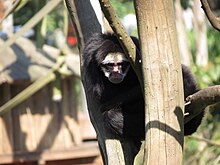White-cheeked spider monkey
| White-cheeked spider monkey | |
|---|---|
 |
|
| Scientific classification | |
| Kingdom: | Animalia |
| Phylum: | Chordata |
| Class: | Mammalia |
| Order: | Primates |
| Family: | Atelidae |
| Genus: | Ateles |
| Species: | A. marginatus |
| Binomial name | |
|
Ateles marginatus É. Geoffroy, 1809 |
|
 |
|
| White-cheeked Spider Monkey range | |
The white-cheeked spider monkey (Ateles marginatus) is a species of spider monkey, a type of New World monkey, endemic to Brazil. It moves around the forest canopy in small family groups of two to four, part of larger groups of a few dozen animals. This monkey feeds on leaves, flowers, fruits, bark, honey and small insects, and it is an important means of seed dispersal for forest trees. Females give birth after a 230-day gestation period. The population of this monkey is decreasing as its forest habitat is lost to soybean production, deforestation and road construction. It is also regarded as a delicacy and hunted for food. For these reasons, the International Union for Conservation of Nature has assessed the animal's conservation status as being "endangered".
The white-cheeked spider monkey is commonly found in the Brazilian Amazon. The area in which it is most likely to be found is between the Rio Tapajós (right bank) and its tributary, the Rio Teles Pires (right bank) and the Rio Xingu (left bank), south of the Rio Amazonas. A portion of their territory lies also within national forests such as Tapajós National Forest (545,000 ha (1,350,000 acres)), Xingu National Forest (252,790 ha (624,700 acres)), Altamira National Forest (689,012 ha (1,702,590 acres)), Itaituba I National Forest (220,034 ha (543,720 acres)), and Itaituba II National Forest (440,500 ha (1,088,000 acres)).
It is more common for the white-cheeked spider monkey to travel in smaller groups of 2-4 when feeding and resting. At around 4–5 years of age, it apparently reaches sexual maturity and will give birth to one offspring after a gestation period of 226–232 days; the interbirth interval can last as long as 28–30 months in the wild.
...
Wikipedia

